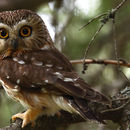pt-BR
nomes no trilho de navegação


Changes in habitat and the time of year may influence the diet of the Northern Saw-whet Owl (Aegolius acadicus). These owls inhabit deciduous, coniferous, and mixed forests throughout the year and eat an array of different animals and insects. Saw-whet Owls most commonly eat small rodents including deer mice and voles - but they have also been known to eat birds and other small mammals (Swengel and Swengel, 1992). Mammal prey also includes woodland speciessuch of mice, jumping mice, chipmunks, and shrews.. Other mammal prey items include a variety of voles including heather voles, Red Tree Voles, meadow voles, montane voles, and red-backed voles. A study of roosting habits and winter food located in north-central Washington found that Northern Saw-whet Owls feed primarily on Western Harvest Mice and deer mice (Grove, 1985).
Northern Saw-whet Owls will also eat an assortment of small birds including juncos, sparrows, chickadees, kinglets, and swallows (Devine & Smith, 2005). They are capable of killing larger birds such as the Rock Pigeon and Northern Cardinal (Lewis, 2015). Insects and frogs may also be included in their diets as well as pocket gophers and squirrels (Cornell Lab of Ornithology, Lewis, 2015). The diet of Northern Saw-whet Owls, like other owls, is easily determined as they regurgitate the skulls, claws, teeth, and feathers of any animal they ingest.
Northern Saw-whet Owls hunt mostly at night and early in the morning using the tactic of sitting and waiting on low perches to drop down onto their prey, on the ground. They also hunt in heavy shrub and wooded areas. An owl may kill up to 6 mice during a plentiful prey season without feasting on any of them (Lewis, 2015). nstead, Northern Saw-whet Owls will cache some of their prey. Caching is the action of hiding prey or storing it somewhere else to save it for later. Owls place their prey across twigs, branches, and even under dirt or other debris. During the winter months in Connecticut, Devine and Smith (2005) observed 16 instances of caching. They noticed that Northern Saw-whet Owls usually keep their prey within 5 cm of them while roosting.
Northern Saw-whet Owls (Aegolius acadicus) reside in forests across the United States, southern Canada and central Mexico. They can be found in different habitats based on the time of year. Saw-whet’s prefer mature forests with underbrush for foraging, riverside habitat in close proximity, deciduous trees to nest in, and roosting in opaque conifers (Cornell Lab of Ornithology). Breeding habitat is usually someplace wet or swampy such as cedar groves, swamps, alder thickets and Tamarac bogs (Lewis, 2015). They nest in a broad range of woodland habitats including deciduous forests, riverside forests, coniferous swamps, savannahs, and shrubby habitats. As secondary-cavity nesters, Northern Saw whet Owls commonly use abandoned Northern Flicker and Pileated Woodpecker holes, but will also use artificial nest boxes; they will not use the same site two years in a row (Kaufman, 2014). The nesting holes that the Northern Saw-whet Owl prefer during the need to have a diameter of 7 cm or larger (Nature Serve Explorer). The nesting site is usually 15-60 ft above ground, Outside of the breeding season, owls may be found in brushy areas, open buildings, dense growth, and arid scrub. During winter they often roost in dense evergreens usually near the trunk.
Eastern populations are most often found at lower elevations in the winter while those in the west reside in mature forests from 1,000 to over 10,000 feet in altitude. However, lower elevation habitats have been used in the winter months for western birds as well (Owling.com, 2001). The terrestrial biomes that this owl is found in encompass forest and taiga biomes, and the habitat is generally temperate forests. Northern saw-whet owls can be found in suburban as well as rural environments. This owl can live in almost any habitat as long as there is dense vegetation and perches for roosting and hunting. They can also be found in agricultural, suburban, or riparian habitats (Yan, 2001).
At just 8 inches in length, the Northern Saw-whet Owl is one of the smallest owl species in North America. Like most owls, this species possesses short legs, rounded wings, large yellow eyes, and a disk-shaped face. Apart from its small size, it may best be identified by its coloration, which is brown spotted with white above and white streaked with brown below and on the face. The Northern Saw-whet Owl breeds primarily in Southern Canada and the northern tier of the United States. Breeding populations also exist at higher elevations in the western U.S. and in the Blue Ridge and Great Smoky Mountains in the southeast. During winter, this species expands its range southward and into lower elevations, including the coastal southeast, the Great Plains, and the southwest. The Northern Saw-whet Owl inhabits forests across the northern part of the continent, and each geographic region in which this species may be found has forests with a different mix of trees. Regardless of the exact species present, this owl prefers forests that are composed either entirely of evergreen trees or of a mix of evergreen and deciduous tree species. In winter, individuals which move outside the species’ breeding range are less tied to a particular habitat type, relocating as new sources of prey become available. Like most owls, the Northern Saw-whet Owl hunts small mammals, including mice, shrews, and voles. This owl uses its excellent hearing to locate prey on the ground in order to fly down and capture it with its talons. Also, like most owls, this species hunts almost exclusively at night, making it difficult to observe. Northern Saw-whet Owls are most visible roosting high in trees during the day or while producing toot-like calls at dusk.